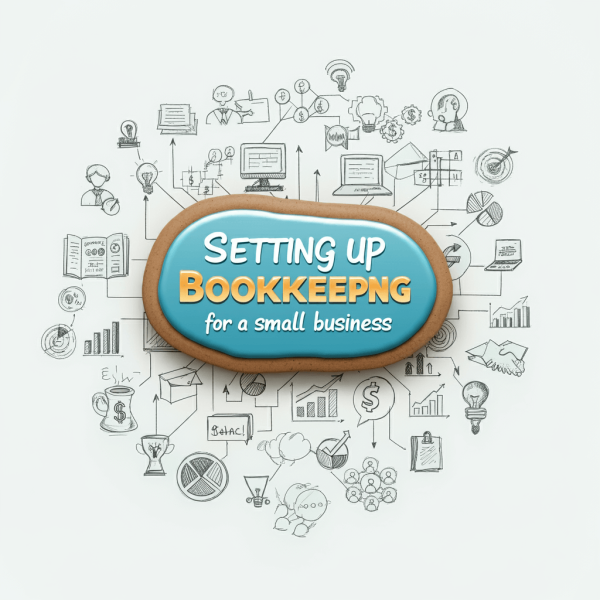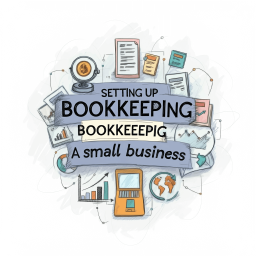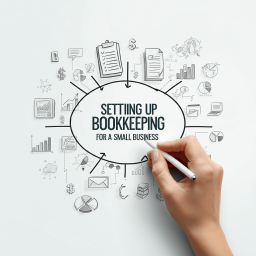Physical Address
304 North Cardinal St.
Dorchester Center, MA 02124
Physical Address
304 North Cardinal St.
Dorchester Center, MA 02124

Starting a new business is thrilling, but many entrepreneurs often overlook a critical aspect: setting up bookkeeping for a small business. Accurate bookkeeping is more than just a legal requirement—it can be a powerful tool for growth, clarity, and informed decision-making. Yet, the process can feel intimidating, especially if you’re new to it.
As an accountant specializing in small businesses, I’ve worked with countless entrepreneurs who felt lost when it came to managing their books. The good news? You don’t have to navigate this alone. By breaking the process into manageable steps, setting up bookkeeping for a small business becomes not just achievable, but empowering and perhaps even a bit of fun!
Before we get into the steps, let’s address why setting up bookkeeping for a small business should be a priority:
One client of mine, a craft brewery owner, struggled to understand why his business wasn’t turning a profit despite strong sales. He had no clue about setting up bookkeeping for a small business. However, once we set up proper bookkeeping, we identified that excessive spending on promotional events was eating into his margins. Armed with this insight, he adjusted his strategy, cut unnecessary costs, and achieved profitability within six months.
Now, let’s look at the actionable steps to build a strong foundation for your bookkeeping.

Bookkeeping is the process of recording, organizing, and maintaining financial transactions. While it sounds technical, the core principles are straightforward. When you are setting up bookkeeping for a small business, you will learn how to do the following:
The key to setting up bookkeeping for a small business is starting with a clear understanding of these basics.
When setting up bookkeeping for a small business, you’ll need to pick an accounting method.
This method records income and expenses only when cash changes hands. It’s simple, making it ideal for small businesses just starting out.
Accrual accounting records income when it’s earned and expenses when they’re incurred, regardless of when money is exchanged. This method provides a more accurate financial picture but can be complex to manage.
A mix of cash and accrual accounting, this option is especially useful if your business manages inventory. For example, you record income and expenses on a cash basis but calculate the cost of goods sold (COGS) annually for tax purposes.
Pro Tip: Most small businesses benefit from starting with cash basis accounting due to its simplicity. However, as your operations grow, switching to accrual accounting may provide better financial insights.
A separate business bank account is essential for clean, professional bookkeeping. Mixing personal and business finances not only complicates your records but also risks legal and tax issues.
When selecting a bank, prioritize low fees, robust online tools, and integration with accounting platforms. Pair your account with a dedicated credit or debit card to further separate business expenses.

Investing in the right tools can make setting up bookkeeping for a small business more efficient and less stressful.
Explore your options and select software that matches your business’s complexity and budget. You can read more in Bookkeeping Software for a Small Business.
Consider tools like Expensify or Hubdoc to digitize and organize paper receipts. These integrations save time and ensure nothing slips through the cracks.
The chart of accounts is a framework for categorizing every financial transaction your business makes. Think of it as your financial filing system.
Most bookkeeping software comes with a pre-built chart of accounts. Tailor it to your business and deactivate unused categories to keep things simple.
Pro Tip: When setting up bookkeeping for a small business and particularly working with your chart of accounts, you’ll soon realize the connection between expense categories and tax deductions for your small business. If you want to learn about tax deductions, I highly recommend that you refer to IRS Publication 334, Tax Guide for Small Business. It is probably not something you’ll be done with in one reading, but it’s a great reference source when you’re wondering about which expenses are tax deductible or not.

Consistency is key when setting up bookkeeping for a small business. Make it a habit to record every transaction—no matter how small.
Real-Life Example:
One client, a wedding photographer, struggled with her year-end taxes because she hadn’t tracked mileage or client-specific expenses throughout the year. By integrating a mileage tracker and automating expense categorization, she saved thousands in deductions the following tax season.
For businesses that work with clients, setting up bookkeeping for a small business must include a professional invoicing system.
Additionally, when setting up bookkeeping for a small business, consider offering multiple payment options—like ACH transfers, credit cards, and online platforms (Stripe, PayPal)—which makes it easier for clients to pay promptly.
An important aspect of setting up bookkeeping for a small business is reconciliation. Reconciliation ensures your financial records match your bank statements. It’s an essential step to catch errors or discrepancies.
Pro Tip: Reconcile accounts monthly to avoid falling behind. Regular reconciliation also helps detect fraud or unauthorized transactions early on.

Taxes are an inevitable part of running a business, but proper preparation through setting up bookkeeping for a small business makes them far less daunting.
After you’ve succeeded in setting up bookkeeping for a small business, use it to generate financial statements. These reports provide valuable insights into your business’s performance.
Review these monthly to spot trends, identify opportunities, and address potential problems before they escalate. You will learn more about how to read and analyze financial statements as you explore the NinaCFO web site.
When setting up bookkeeping for a small business, you’ll learn that bookkeeping isn’t a one-and-done task. Through setting up bookkeeping for a small business you learn that it’s an ongoing process that requires discipline and adaptability.
I’d like to stress the advantage of spending a few minutes every day on your bookkeeping. It’s almost like exercise; a few minutes every day is better than an hour on the weekend. By looking at your books every day, it becomes a routine, and this makes it very easy to learn setting up the bookkeeping for a small business.
As your business grows, consider outsourcing bookkeeping to a professional. While DIY bookkeeping works for startups, hiring an expert saves time and ensures accuracy as your finances become more complex. When you get to the point where you feel that your time is better spent elsewhere, figure out the dollar amount that an hour of your time is worth. Then figure out how much you would have to pay to get your bookkeeping professionally done. For more information about outsourcing, see Outsourced Bookkeeping.

Proper bookkeeping isn’t just about crunching numbers—it’s about empowering your business to thrive. Here’s how setting up bookkeeping for a small business can drive real results:
By taking the time to set up your bookkeeping system correctly, you’re investing in the long-term success of your small business. A well-managed financial foundation today sets the stage for sustainable growth tomorrow!
Start your bookkeeping journey today, and don’t forget to subscribe to NinjaCFO Insider for more tips and tools to help your small business thrive.